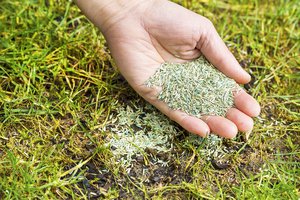
by Flagship Staff | May 28, 2019 | Blog
Are you disappointed with how your lawn looks this spring? Do you have bare spots? Harsh winters, insects, animals, and disease can wreak havoc on your lawn. While I’m not striving for the perfect lawn, I do take pride in having a nice, healthy one.
If you’re frustrated with how your lawn looks and you want to fix the bare spots, you can! For existing lawns, lawncare professionals recommend core aeration and over seeding in the fall. This process promotes overall healthy growth and can help thicken it. However, you can add seed to your lawn in the spring and experience good results.
Here are some tips for fixing your lawn.
1. Determine the best time to plant. Depending on where you live, certain times of the year will generate better results. In the Midwest, cool-season grass seeds will germinate when soil temperatures consistently range between 50 and 65 degrees Fahrenheit. If you live in southern states, warm-season grass seed will germinate when soil temperatures are between 70 and 80 degrees Fahrenheit.
If the soil temperatures are confusing, a less technical rule of thumb is grass seed germinates when the air temperature is consistently between 60 and 80 degrees Fahrenheit.
Lastly, if you experience a cool spring or summer, germination may take longer, or it may fail.
2. Prepare the site. Watering a bare spot will not get the grass to regrow. Site preparation is needed. Before planting the seed, make sure that weeds, exiting grass, sticks, and rocks are removed. After the area is cleaned up, rough up the soil or lay down some fresh topsoil. The layer of topsoil only needs to be about a quarter inch thick. This allows the seed to connect with the soil. Laying seed on a hard, compact surface won’t work well.
3. Select the appropriate grass seed. This may seem like a no brainer. All you need to do is visit your local retail store and buy what’s on their shelves, right? While your local retail store will carry products that contain a mixture of seed that’s appropriate for your area, there are a few things you should consider.
Does your lawn get full or partial sun?
Do you have pets?
Does your lawn get light, moderate, or heavy foot traffic?
For example, Kentucky Bluegrass or Bermudagrass are good for heavy-traffic lawns. Perennial Ryegrass is good for light to moderate traffic.
For small areas I’ve used a product that contains a combination of grass seed, mulch, and fertilizer all in one and enjoyed success.
4. Determine the correct grade. For small patch jobs, determining the correct grade isn’t critical. All you need to do is make sure the soil is flat. If you’re reseeding your entire yard, you can do it yourself however, the process is more complicated. Your yard should be graded so that water flows. The last thing you need or want is large mud puddles in your yard or water running towards your home. If you run into trouble, contact your local landscape professional.
5. Apply the seed. Gently sprinkle the seed on the bare spot until it’s sufficiently covered. You still should be able to see the soil.
6. Water gently. After you’ve planted your grass seed, briefly and gently water the soil two to five times per day. The number of times to water will depend on the temperature. The goal is to keep the soil moist.
7. Don’t get frustrated. Depending on the type of grass seed you’ve planted, germination can take from 5 to 30 days. If you don’t see acceptable results after 30 days, give the process another try, or consider waiting until fall.

by Flagship Staff | May 22, 2019 | Blog
Do you remember buying your first new car? Or how about adding a teen driver to your policy? These experiences are often exciting and signify milestones in our lives.
However, these milestones come along with the responsibility to purchase auto insurance. Buying auto insurance isn’t as exciting.
Auto insurance includes different types of coverages, such as Comprehensive, Collision, and Liability. Trying to figure out the appropriate insurance coverage needed and the appropriate insurance limits to carry can be daunting.
In today’s litigious society, it’s crucial to make sure you have adequate liability insurance limits. Currently, liability insurance is required in 49 of 50 states. The limits required in each state may be different and may only be minimum requirements.
If you’re responsible for causing an auto accident and injuring another person or damaging their property, you could be held financially liable for damages if you’re underinsured.
The different types of Liability insurance limits available;
Auto accident scenarios; and
How the different coverage limits apply.
Remember, it’s important to buy as much liability insurance as you can afford. Big losses usually occur on the liability side. If you don’t have enough liability insurance, you may be held personally and financially liable for the injuries and property damage you’ve caused.
If you have questions about your auto insurance policy, contact your insurance agent. Finding out after a loss that you don’t have adequate liability insurance limits isn’t a good situation for you or your insurance company.

by Flagship Staff | May 14, 2019 | Blog
Having your perfect wedding and buying your dream home are both exciting milestones, full of new adventure and hopeful possibility. However, both events require a significant amount of careful logistical and financial planning. There are so many little details to work out, that when challenges arise, it’s difficult to keep everything from falling apart. But have no fear! There are plenty of helpful tools to help you steer your big day and your big move into smooth sailing.
Set Financial Goals
Budget, budget, budget! It’s important to sit down as soon as possible and decide what you need and what you want out of each experience. Give each item careful consideration and strike a balance between what’s most desirable, and what’s reasonable. If you’re too conservative with your plans and your money, you may not be able to enjoy the wedding and the home of your dreams. If you’re too ambitious, you may find yourself in a sticky monetary situation. Finding that sweet spot is your first step toward your future.
Once you’ve created a budget, start setting aside a percentage of your income each month. Cut down on any extras and limit your splurging. If you need a bit of extra help, budget planning apps like WeddingHappy and Mint can help you set goals, plan out timelines, and keep track of your spending.
Check it Twice
Embrace the checklist! You’re less likely to forget to make that phone call, book that caterer, or meet with your real estate agent if you have everything written down. Put your action items in order of priority and create smaller lists for each of those big jobs. Be diligent about checking it each day. If you need help knowing what needs to be on your to-do lists, start with this moving checklist to get you started and adapt it to fit your needs.
Stick to a Schedule
Not only is it essential to maintain a strict financial schedule but wedding bells and moving vans also come with meticulous logistics that are time sensitive. Most wedding venues, photographers, florists, and caterers are booked months–at times, years–in advance. Once you set dates and finalize plans, keep a neatly organized list of contact numbers and dates for check-ins. Mistakes happen, and if something falls through the cracks or goes awry, you’ll want to know as soon as possible so that you can resolve the issue, or make other arrangements. The Knot and Lady Marry are both excellent wedding planners, and these apps will help you stay on top of everything else!
Delegate
Every dollar, every hour, and every task should have a designated purpose when juggling your move and your wedding. So, don’t be afraid to ask for help! Delegate tasks to trusted friends and family, and make sure to maintain clear and honest communication well ahead of time. That way, you can take care of the big stuff while others can make phone calls, help you pack, and pick up essentials.
Hire Professionals
When it comes to wedding plans, always be sure to hire professionals. Relying on friends, family, or friends of friends for photography and catering can cause tension in your personal relationships, adding extra and unnecessary stress to your itinerary. However, don’t hesitate to ask them for recommendations! If you’re still unsure of who to hire, you can use crowdsourcing apps like Yelp and choose vendors that suit your particular needs.
While hiring movers can get a little pricey, they can save you a lot of precious time and lots of stress. As experts in their field, they have plenty of experience in packing, loading, and unloading belongings. Be sure to get a few estimates before you decide to move forward with a moving company!
Insurance
Unfortunately, sometimes things don’t go quite according to plan, and you’ll want to be covered in the event of an emergency, accident, or other unforeseen event. On top of contingency plans with your individual wedding vendors, look into moving insurance, wedding insurance, and home owners insurance to protect you if things go wrong. It’ll give you peace of mind that’s well worth the investment.
While West Bend doesn’t offer wedding insurance, your independent insurance agent should be able to find coverage.
Self-Care
Lastly, it’s critical to remember that your move and your wedding are intended to be blissful gateways into your new life with your partner. Chances are, you’ll be juggling these changes on top of work, school, and family, which can get very exhausting and stressful. Make time for yourself, and for your relationship. Treat yourself to some pampering, even if it’s just a hot bath at the end of a long day. Plan date nights, a few weekends away, and small treats to enjoy in between your planning time. When you take care of yourself and your relationships, you’re better equipped to handle curveballs as they come!

by Flagship Staff | May 7, 2019 | Blog
May is Motorcycle Safety Awareness Month. As the weather begins to improve, more motorcyclists will bring their motorcycles out of storage. If you’re a rider, this is an exciting time of year. If you’re a motorist, it’s important to be on the lookout.
Unfortunately, motorcyclist deaths occur 28 times more frequently than deaths of occupants in other vehicles. In 2017, 5,172 motorcyclists lost their lives. While deaths were down 114 people from 2016, it’s way too many.
While I don’t own a motorcycle, I do enjoy riding on two wheels. I enjoy riding my Trek bicycle and my Yamaha Zuma scooter. Both rides have me sharing the road with other motorists. Often motorists don’t see me even though I wear bright colors and have headlights and tail lights that are extremely bright during daylight hours.
Not all motorcycle accidents are the result of a collision with another vehicle. Animals, debris on the road, and not wearing a helmet can all contribute to injuries and death.
Here are some safety tips for motorists, as well as all two wheeled enthusiasts.
>Motorists
Double check your blind spots. Because of their speed and size, motorcycles may quickly come in and out of your blind spots. Always take a second look now that motorcycles are out on the road.
Assess your surroundings. Always be on the lookout when approaching intersections or making a left-hand turn. Covering the brake pedal is a good idea as you drive through an intersection.
Allow plenty of distance. Allow plenty of distance between you and a motorcycle when braking. A motorcyclist may not always use their breaks when decelerating. They may be decelerating by down shifting or simply letting off the gas.
Watch out for flashing turn signals. Turn signals on motorcycles may not be self-canceling and the motorcyclist may have forgotten to turn it off. Wait to be sure the rider is going to turn before you proceed.
Know and follow the laws. Safe passing laws require a motor vehicle to allow no less than three feet of clearance when passing a bicyclist. The Dooring law states that a person in a parked car DOES NOT have the right to open the door at any time. A driver or passenger may only open a door when it’s reasonably safe and doesn’t interfere with the movement of traffic.
Watch for road debris. Especially right after winter, road debris is a big concern. There can be a build up of salt and sand on the side of the road if you haven’t had a good, steady, heavy rain in your area. This could result in slippery conditions.
Watch out for potholes. After a brutal winter, potholes can be found in new places. Hitting one could send you flying or severely damage your motorcycle.
Wear a DOT compliant helmet. You’re much more likely to sustain major injuries in a traffic collision if you don’t wear your helmet. Wearing it always when operating a motorcycle is crucial.
Watch for animals. If you’re riding after dusk in the country or through wooded areas, consider reducing your speed. Hitting an animal at a high rate of speed can send you flying. In addition, never swerve to miss striking the animal. This can put you in the lane of oncoming traffic or driving towards a tree. Brake as hard as you can until impact.
Navigate turns cautiously. Accidents are very common on curves and bends in the road. Pay attention to signs warning of curves and slow down to the suggested speed limit.
Pay attention to the weather. Always be aware of weather changes. Rain can make the pavement slippery. If you add leaves to the mix, pavement conditions can be extremely dangerous. Poor weather conditions can also make it difficult for other motorists to see you.
Drive in the left side of the lane. Driving here helps you to be more visible to motorists.
Bicyclists
strong>
Make sure your bike is in proper working condition. This means making sure bolts are tight, brakes work, chains are lubed, and tires are inflated to the manufacture’s recommend tire pressure.
Consider buying some accessories for your bike. Accessories can make your commute to work safer and more enjoyable. A mirror, bell, headlight, and taillight are very important accessories. All of them help you navigate and safely manage your surroundings.
Obey all traffic laws. It happens all too often that bicyclists are seen running stoplights or riding on the wrong side of the road.

by Flagship Staff | Apr 30, 2019 | Blog
Warm spring days are a nice preview of what’s to come as we approach summer. However, spring weather is also very unpredictable. Temperatures fluctuate between warm and cool. A stretch of nice sunny days can be followed by wet stormy days. Lightning, wind, rain, and hail can cause damage to your property very quickly.
According to Tom, West Bend claims manager, storms can damage things on your property that you may not normally think about. When Mother Nature damages items such as decks, fences, swimming pools, hot tubs, piers, and docks, claims payments made in accordance with the policy can be confusing. Depending on if an item is considered a separate structure or part of a building determines if the claim payment will be made on an actual cash value (ACV) or replacement cost value (RCV) basis.
Before delving into different claims scenarios, it’s important to understand the difference between actual cash and replacement cost value.
Actual Cash Value (ACV)
Actual cash value is an amount of money that’s paid to a policyholder after a loss or damage to insured property. The calculation is made by subtracting depreciation from replacement cost. Depreciation is calculated by determining the expected lifetime of an item and calculating what percentage of the life remains.
Replacement Cost Value (RCV)
Replacement cost is an amount of money that’s paid to a policyholder after a loss or damage to an insured property. This amount of money is based on what it would cost today to replace an item or structure back to its pre-loss condition.
Now that you understand these claim payment options, here are some common claims scenarios that are handled by our Claims department.
Claim Scenario #1
You’ve finally purchased the home of your dreams. It’s in a quiet subdivision and it has a detached white picket fence. The backyard has several lovely shade trees, but they still allow sunlight into your pool. The pool is surround by a nice wooden deck that’s attached to your home. Also, sitting on the deck is a hot tub. You can’t wait for summer to arrive so you can invite your friends and family over for a pool party. Unfortunately, just before summer, a severe storm goes through your neighborhood. Not much remains of your white picket fence. Your pool and deck are severely damaged by one of your large shade trees. Thankfully you have an insurance policy with adequate coverage limits. A claim adjuster has visited your property and has determined the following claim payments.
Item
ACV
RCV
Claim Payment
Detached white picket fence
$3,000
$5,000
$3,000
Swimming pool
$5,000
$10,000
$10,000
Wooden deck
$4,000
$7,000
$7,000
Hot tub
$5,000
$10,000
$10,000
Your total claim payment from this storm is $30,000.
Claim Scenario #2
You’ve just purchased a home in the country on several acres of land. There are no neighbors in sight. Nothing but fresh air and peace and quiet. Your yard includes a fence that’s attached to your home. All you must do is open your patio door and your dog, Rosie, can go out and play. Away from your home you have a large above ground swimming pool. And after a hard day’s work, you really like using the hot tub just off the wooden deck on a separate concrete patio. Unfortunately, a warm spring day finished with a severe storm that damaged your property.
Again, you have an insurance policy with adequate coverage limits. A claim adjuster has visited your property and has determined the following claim payments.
Item
ACV
RCV
Claim Payment
Chain link fence
$3,000
$5,000
$5,000
Swimming pool
$5,000
$10,000
$5,000
Wooden deck
$4,000
$7,000
$7,000
Hot tub
$5,000
$10,000
$5,000
Your total claim payment from this storm is $22,000.
Insurance Coverage
In both scenarios above, the actual cash value and replacement cost value numbers are the same. However, the claim payment made in each is different. The differentiation is based on if the item is attached to your home or not. If it’s not attached to your home, it may be considered a separate structure. Separate structures that aren’t buildings are covered on an actual cash value basis.
In Claim Scenario #1, the hot tub is considered part of your home because it’s sitting on the deck which is attached. In Claim Scenario #2, the hot tub is on a concrete patio which isn’t attached to your deck. Therefore it’s considered a separate structure and the claim payment is made on an actual cash value basis.
Regarding the swimming pools, neither one of them is literally attached to the home. However, in Claim Scenario #1 the pool is surrounded by a wooden deck that’s attached to the home. Therefore, the claim payment for the pool is made on replacement cost value basis. The pool in the country is a separate structure so the claim payment made is based on actual cash value.
Lastly, claim payments for the fences are different too. In Claim Scenario 1, the white picket fence isn’t attached. In Claim Scenario 2, the fence is attached so Rosie can go outside and play.
So, you think you’ve got it figure out?
Claim Scenario #3
After 40 years of work you’ve decided to retire and buy a home on a beautiful lake. After researching a variety of docks, you decide to purchase a dock that must be taken out of the water before it freezes each year. Your neighbor’s dock is permanent and is made to withstand snow and ice. After a crackle and boom on the 4th of July a severe storm pushes through the area. Fallen trees severely damage your new dock, as well as your neighbor’s. Again, you have an insurance policy with adequate coverage limits. A claim adjuster from your insurance company has visited your property. A claims adjuster from Insurance Company B has visited your neighbor’s property.
Item
ACV
RCV
Claim Payment
Your dock (Your insurance co)
$10,000
$20,000
$20,000
Neighbor’s permanent dock (Ins Co B)
$10,000
$20,000
$10,000
Insurance Coverage
In Claim Scenario #3, the payment for each dock is different. You’re probably wondering why because they’re both separate structures and not attached to a building. Because your dock is stored on land during the winter months, it’s considered personal property making it eligible for replacement cost value.
Final Thoughts
Insurance isn’t fun to buy and can be difficult to understand. Hopefully understanding actual cash value and replacement cost value makes the claims process easier to understand. Finding out how items are covered after a loss isn’t a good situation for you or your insurance company.
At a minimum, talk to your independent agent on a yearly basis to review your insurance policy.

by Flagship Staff | Apr 16, 2019 | Blog
Now that spring’s here, it’s time to give your home a post-winter scrub down. While it feels great opening the windows and letting the fresh air in, there’s much more work to do. Besides your regular house cleaning, here are some things that often get overlooked or forgotten.
1. Carpet. In our home, my wife and I frequently vacuum as a part of our normal cleaning routine. It’s unbelievable how much dirt, dust, and debris are in the container after we’ve finished. If you have a pet, you’ll notice even more.
Now that nicer weather’s here, it’s a great opportunity to deep clean your carpets by yourself or by hiring a professional. If you think about where your shoes travel, you may move this up on your “to-do” list. If you choose to hire a professional, consider:
Asking friends or neighbors for referrals;
Researching companies in your area;
Contacting the Better Business Bureau;
Understanding the services offered;
Getting the contract in writing; and
Confirming the company you select carries insurance.
2. Base boards. Have you ever looked behind your entertainment stand? If so, you probably found a significant amount of dust on the base boards. Or how about your kitchen base boards? Do they have food particles or spilled juice on them? Now’s a good time to wipe down all the base boards in your home.
3. China cabinet. Have you gone through your china cabinet lately? My guess is, probably not. We recently updated our kitchen. As part of the process, we went through ours. Not only was the glassware full of a thick layer of dust, and the silver tarnished, there were many items we haven’t used in a long time. With wedding season right around the corner, now’s the time to purge. Consider donating your unused items to local charities or collection centers.
4. Dryer vent/lint trap. Between 2010-2014, U.S. fire departments responded to approximately 15,970 home fires that resulted from dryers or washing machines. Lint is extremely flammable and can cause a fire in your home resulting in significant damage. To prevent this from happening to you, consider cleaning your dryer vent and ducts at least once a year. If you can’t easily do this, consider hiring a professional. Your lint trap should be cleaned before or after each load.
5. Blinds. While, we clean every week, our blinds are neglected. We open and close them every day but fail or pretend not to see the dirt and dust. Look at yours. I’ll bet you’ll be surprised on how dirty they are. And don’t forget about your curtain rods.
6. Windows. Rather than wait for the flies to come back to life, clean your window sills and the screens if they’re dirty.
7. Bathroom vents. Bathroom vents are important for removing the steam from your bathroom after a nice, hot shower. However, over time they become covered in dust. Wipe them down with a damp rag or use your vacuum.
8. Light fixtures and ceiling fans. Ah, the first warm day has arrived. You decide to turn on your ceiling fan for some circulation, and dust starts flying everywhere. Enjoy your first warm day by cleaning them now.
9. Shower curtain/liner. Bathrooms are very conducive for mold growth. If your shower curtain has changed from white to pink, red, black, or dark green, you’re growing mold. Now’s the time to buy a new one.
10. Light switches, door handles, and hand rails. It’s always good to sanitize these items after you or a family member have been sick. If time hasn’t previously allowed you do this, add it to your list.
Cleaning hacks
Here are some cleaning hacks for tackling other areas of your home.
Clean your dishwasher with vinegar.
Use lemon to remove watermarks on your shower doors.
Remove grease build up on your kitchen cabinets with soap.
Remove pet hair from surfaces with a rubber glove or squeegee.
Clean your windows with old newspaper.
Descale your shower head and faucets with vinegar.
Microwave a bowl of lemons and water or cider vinegar to get rid of tough odors and stains.






